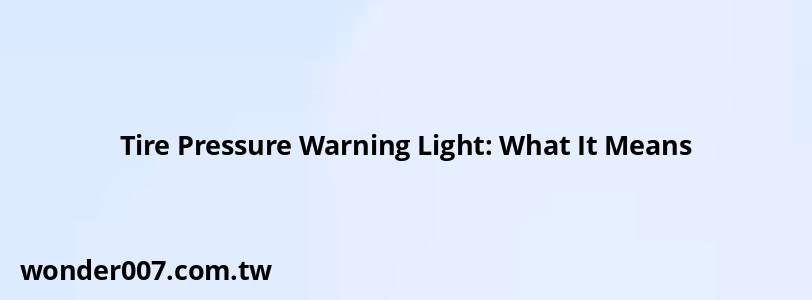Tire Pressure Warning Light: What It Means

Understanding the Tire Pressure Warning Light
The tire pressure warning light, also known as the TPMS (Tire Pressure Monitoring System) light, is a crucial safety feature in modern vehicles. This warning indicator typically appears as a yellow symbol resembling a horseshoe-shaped tire cross-section with an exclamation point inside.
When this light illuminates on your dashboard, it signals that one or more of your tires have significantly low air pressure. The TPMS is designed to alert drivers when tire pressure falls approximately 25% below the manufacturer's recommended level.
Why Proper Tire Pressure Matters
Maintaining correct tire pressure is essential for several reasons:
- Ensures optimal vehicle handling and stability
- Improves fuel efficiency
- Extends tire life by reducing uneven wear
- Enhances overall safety by reducing the risk of blowouts
Common Causes of TPMS Light Activation
Several factors can trigger your tire pressure warning light:
- Gradual air loss over time
- Sudden puncture or leak
- Temperature fluctuations (especially in colder weather)
- Faulty TPMS sensors
What to Do When the Light Comes On
If your tire pressure warning light illuminates, follow these steps:
1. Safely pull over as soon as possible
2. Check all tire pressures with a reliable gauge
3. Add air to underinflated tires to reach the recommended PSI
4. If the light persists, have your tires and TPMS inspected by a professional
Types of Tire Pressure Monitoring Systems
There are two main types of TPMS:
| Direct TPMS | Indirect TPMS |
|---|---|
| Uses sensors in each tire | Uses ABS wheel speed sensors |
| More accurate | Less expensive |
| Can display individual tire pressures | May not identify which tire is low |
Maintaining Your TPMS
To ensure your TPMS functions correctly:
- Regularly check tire pressures, even if the light is off
- Have TPMS sensors checked during tire rotations or replacements
- Replace TPMS sensor batteries when necessary (typically every 5-7 years)
Remember, the TPMS is a helpful tool, but it doesn't replace regular tire maintenance. Always visually inspect your tires and check pressures monthly for optimal safety and performance.
FAQs About Tire Pressure Warning Lights
- Can I drive with the tire pressure light on?
While possible for short distances, it's not recommended. Low tire pressure can lead to poor handling and increased risk of tire failure. - Why does my TPMS light come on in cold weather?
Tire pressure decreases in cold temperatures. Check and adjust your tire pressure when temperatures drop significantly. - How do I reset my TPMS light after adding air?
Usually, driving for a few minutes will reset the system. If not, consult your vehicle's manual for specific reset procedures.
Related Posts
-
Acura MDX Dashboard Warning Lights Explained
26-01-2025 • 137 views -
Chevrolet Captiva: How to Reset Warning Lights Easily
27-01-2025 • 252 views -
JLG Boom Lift Warning Lights: Complete Guide
26-01-2025 • 257 views -
Engine Warning Light: What to Do When It Comes On
29-01-2025 • 219 views -
Mini Cooper Warning Light Meanings: A Comprehensive Guide
26-01-2025 • 206 views
Latest Posts
-
2015 Chevy Traverse AC Recharge Port Location
01-02-2025 • 418 views -
Rear Brake Caliper Piston Won't Compress
01-02-2025 • 361 views -
Are O2 Sensors Covered Under Warranty
01-02-2025 • 378 views -
How To Turn Off Paddle Shifters Mercedes
01-02-2025 • 387 views -
Power Steering Fluid Leak On Passenger Side
01-02-2025 • 461 views
Popular Posts
-
EPC Light: Understanding Causes and Solutions
26-01-2025 • 1065 views -
Power Steering and ABS Light On: Causes and Solutions
27-01-2025 • 649 views -
Hino Warning Lights: Understanding Dashboard Alerts
26-01-2025 • 795 views -
Toyota Hiace: Fuel Efficiency Insights for 2025
26-01-2025 • 646 views -
V12 Engine Costs: What You Need to Know
26-01-2025 • 688 views
